Farmers' Awareness Towards TNAU -AAS Web Cum Mobile App for Western Agro Climatic Zone (ACZ) of Tamil Nadu
Kokilavani Sembanan1
*
 , Ramanthan Subbiah1
, Ramanthan Subbiah1
 , Dheebakaran Ganesan1
, Dheebakaran Ganesan1
 , Sathyamoorthy Nagaranai Karuppasamy1
, Sathyamoorthy Nagaranai Karuppasamy1
 and Janakirani Albert2
and Janakirani Albert2

1
Agro Climate Research Centre,
Tamil Nadu Agricultural University,
Coimbatore,
Tamil Nadu
India
2
Department of Agricultural Extension and Rural Sociology,
Tamil Nadu Agricultural University,
Coimbatore,
Tamil Nadu
India
Corresponding author Email: kokilavani.s@tnau.ac.in
DOI: http://dx.doi.org/10.12944/CWE.18.2.12
Copy the following to cite this article:
Sembanan K, Subbiah R, Ganesan D, Karuppasamy S. N, Albert J. Farmers' Awareness Towards TNAU -AAS Web Cum Mobile App for Western Agro Climatic Zone (ACZ) of Tamil Nadu. Curr World Environ 2023;18(2). DOI:http://dx.doi.org/10.12944/CWE.18.2.12
Copy the following to cite this URL:
Sembanan K, Subbiah R, Ganesan D, Karuppasamy S. N, Albert J. Farmers' Awareness Towards TNAU -AAS Web Cum Mobile App for Western Agro Climatic Zone (ACZ) of Tamil Nadu. Curr World Environ 2023;18(2).
Download article (pdf)
Citation Manager
Publish History
Select type of program for download
| Endnote EndNote format (Mac & Win) | |
| Reference Manager Ris format (Win only) | |
| Procite Ris format (Win only) | |
| Medlars Format | |
| RefWorks Format RefWorks format (Mac & Win) | |
| BibTex Format BibTex format (Mac & Win) |
Article Publishing History
| Received: | 2023-01-19 |
|---|---|
| Accepted: | 2023-06-19 |
| Reviewed by: | 
 Fernando Emilio Valladares Fuente
Fernando Emilio Valladares Fuente
|
| Second Review by: |

 Monika Bajaj
Monika Bajaj
|
| Final Approval by: | Dr. Marta Luciane Fischer |
Introduction
Early warnings and climate forecasts have a great potential to prevent weather-related losses and damage to agriculture. Due to global warming, it is predicted that farm income will decrease by 15 to 25 percent, and economic losses will get worsen as temperatures rise1. The sensitivity to climate change makes it more difficult to achieve food security and the Sustainable Development Goals (SDG), primarily because it has a diverse range of effects on the most vulnerable2.
Tamil Nadu recorded with the highest frequency of droughts during the past century3. Due to the lack of a monsoon, the semi-arid state experienced major damage from drought in the most recent years, 2002–2003, 2009 2016 and 20194. Tamil Nadu's weather-based hazards, which include hereditary geo-location risks, transferrable risks, and risks that can be reduced by the introduction of technology to crop yield, are distinct from those in most other Indian states5.
In developing nations, mobile phone technology has given farmers a good platform to exchange knowledge and information with one another on the move, such as market rates and weather information6,7. Men and women now have easier access to information thanks to mobile phones, raising their level of living8,9.
The Automated Weather-based Agro Advisory Service (AAS) from TNAU is the best alternative for responsive farming and promoting sustainability in farming amid climate variability and climate change. This web cum mobile app was developed by the Scientists of Tamil Nadu Agricultural University, Coimbatore. Given that all agricultural operations depend on the weather, AAS is regarded as a blessing for the farming sector. AAS is weather-smart and understands the needs of farmers10.
With this background, an analytical study was taken up with the objective of to know the farmers’ perception awareness about the TNAU-AAS – Web cum Mobile App in western Agro Climatic Zone of Tamil Nadu.
Materials and Methods
Study Area and period
The current investigation was purposefully carried out in selected blocks viz., Anamalai, Thondamuthur, Annur, Karamadai, Pollachi North of Coimbatore and Pongalur block from Tiruppur from March 2021 to March, 2022 (Figure1).
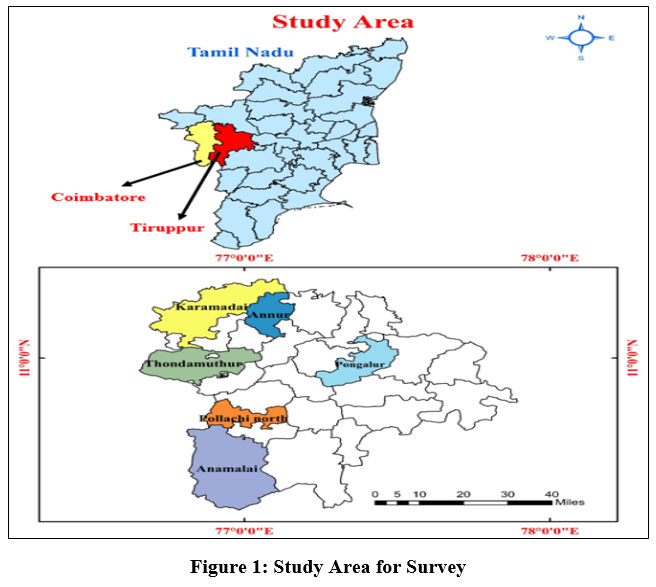 | Figure 1: Study Area for Survey
|
TNAU-AAS App
The block-level Automatic Weather Station (AWS) placed at Tamil Nadu will continuously sense the weather data and communicate with the central server of the Tamil Nadu Agricultural University. Using regional climate models (WRF), the block level weather forecast with a lead-time of 6 days will be created and stored on the server. The weather data from the previous six days and the six-day prediction will be combined to create weather-based agro advisories at the block level, which will be distributed to farmers via mobile SMS for the important crops. These 54 weather windows can be used to produce agro advisories for specific crops to be distributed to farmers in a domain area under automated agro advisory services with certainty and can be seen in aas.tnau.ac.in (web page) and mobile app. Through social media, the farmers are aware of the agriculture portals which helps the farmers to know and share the weather based agro advisories.
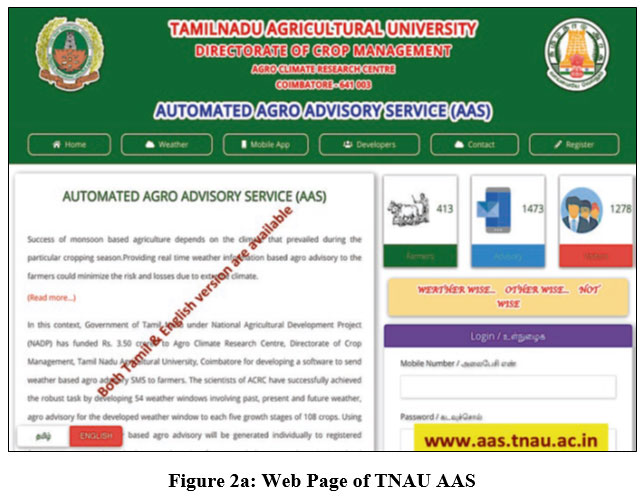 | Figure 2a: Web Page of TNAU AAS
|
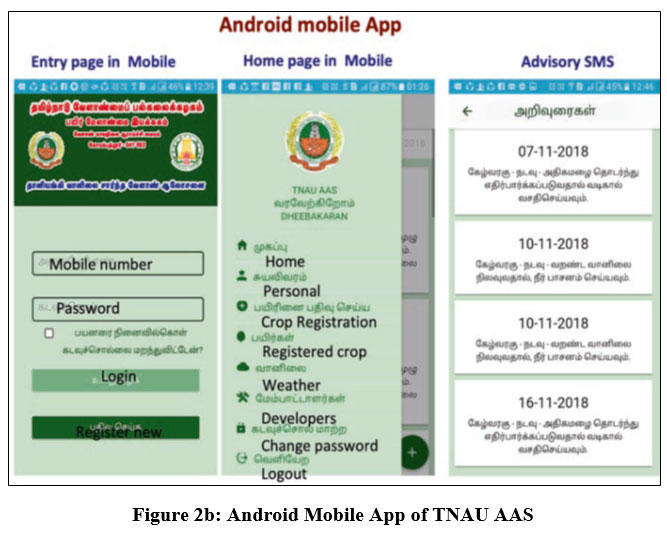 | Figure 2b: Android Mobile App of TNAU AAS
|
Farmers’ Survey and Interviews
In the context of the agricultural information sources that were accessible in the study area, the current study considered the usage of mobile phones for information transfer. A random sample of 40 farmers was selected from each representative blocks of the study area. The frequency and percentage analysis were employed to assess the farmer´s knowledge and perception about agromet advisory services. The convenience sample approach was used for getting the information regarding the access to internet on mobile phone. Due to pandemic situation prevailed during the study period (March 2021- March 2022), all the required details were collected using telephonic survey from the respective blocks. During pandemic period the data were collected through telephonic conversation with 180 farmers and through WhatsApp group. During post pandemic period, survey was conducted with 60 farmers. All together 240 samples were collected for the study. But no variations were observed in the farmer’s response during the above said periods. The data also include information on farmer’s perception towards Agromet Advisory Services in the Western Agro Climatic Zone of Tamil Nadu.
Results and Discussion
Socio-economic characteristics of farmers in Western ACZ
The socio-economic characteristics of farmers in the Western ACZ of Tamil Nadu is given in Table 1. Considering the age, the respondents from middle age was 43 per cent followed by young age with 35 per cent. The educational status of the farmers inferred that 44 per cent completed Higher Secondary graduation followed by 38 per cent of the respondent’s completed graduation. 73 per cent of the respondents were male while 27 per cent were female. In the WACZ, 41 per cent of the respondents had 16 to 25 years while 31 per cent had more than 25 years of farming experience respectively. The land holding information inferred that 69 per cent of the respondents hold medium size of land holding while 17 per cent of the respondents had large farm size. TNAU- AAS app requires knowledge to input the basic information given in the app and continuous follow up in receiving the SMS is needed for the successful weather based information. Since, 44 per cent of the respondents had Higher Secondary school of education and majority had middle age group, whom were more interested in handling this app. A line of confirmation with this study was given11.
Table 1: Socio-economic characteristics of farmers in Western ACZ of Tamil Nadu(n=240)
S. No | Particulars | TNAU-AAS -App registered farmers | ||
Category | Frequency | % | ||
1 | Age(Years) | Young(<35) | 84 | 35 |
|
| Middle(>36-45) | 103 | 43 |
Old(>46) | 53 | 22 | ||
2 | Education | Secondary | 43 | 18 |
|
| Higher Secondary | 106 | 44 |
Graduation | 91 | 38 | ||
3 | Gender | Male | 175 | 73 |
Female | 65 | 27 | ||
4 | Farming experience | Low (up to 15 years) | 67 | 28 |
| Middle (16 to 25 years) | 99 | 41 | |
High (> 25 years) | 74 | 31 | ||
5 | Land Holding (ha) | Marginal & Small (< 2.5 acre) | 35 | 14 |
| Medium ((>2.5 to 5 acre) | 165 | 69 | |
Large (> 5 acre) | 40 | 17 | ||
Farmers access to Information source on New Technology
Farmers in the study had potential access to smart phones and this was in accordance who reported that the third generation of mobile phones were widespread among farmers12. Smart phones (83 %) had an easy-to-use features and applications and act as widely used source of information acquisition due to its high frequency of utilization13. This was followed by Progressive farmers (78 %) by which face to face interaction was possibledue to geographical proximity of the fields. Parallelly, Newspapers (75 %) have separate page for farming community to discuss the important topics related to agriculture (Figure 3). Farmers are said to adopt and utilise mobile phones more frequently for agricultural purposes since they are better equipped to do a number of tasks, like receiving SMS and downloading web-based applications, on smartphones 14,15.
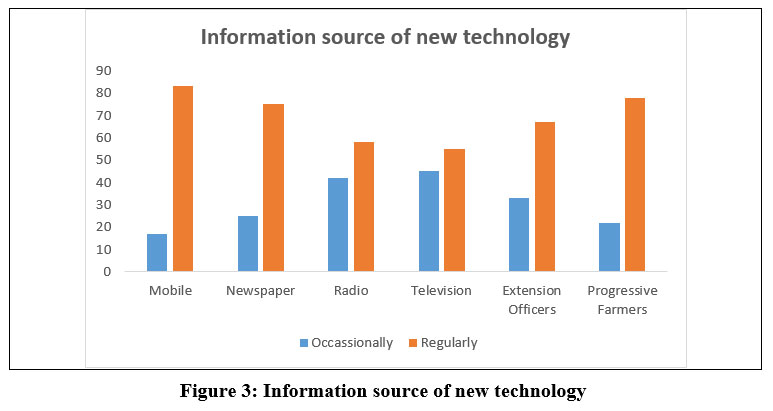 | Figure 3: Information source of new technology
|
Farmers access to Agricultural Portals through social media
The smart phones were widely used by the farmers as a source and medium to obtain information regarding farming to make better decisions. 75 per cent of respondents used Whats app to know about agricultural portals through social media (Figure 4) Since, most of the respondents in the study area comes under middle and young age group, they were familiar in creation of whats app group and sharing of the farm new practices.
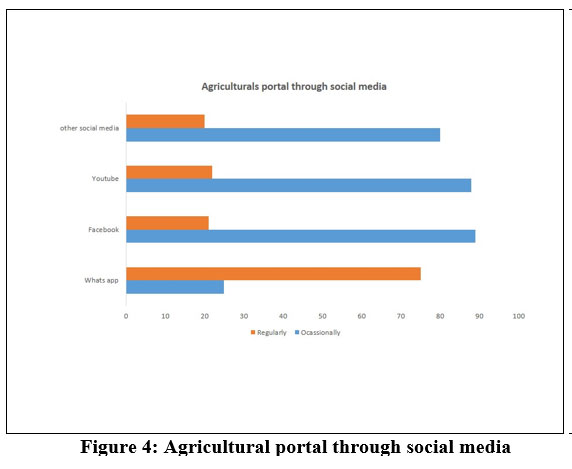 | Figure 4: Agricultural portal through social media.
|
Farmers exposure to weather forecast
Among the different modes of exposure to weather forecast, 80 per cent respondents use mobile app to know about weather forecast (Figure 5). Many weather apps are available in the smart phones which ease the farmers to know about the weather forecast locally. Moreover, SMS from TNAU were accessed regularly by more than 60 per cent of the respondents to take up the tactical farm decisions. Another study in line found that farmers preferred to get weekly weather-based agricultural advise services from TNAU agricultural specialists16.
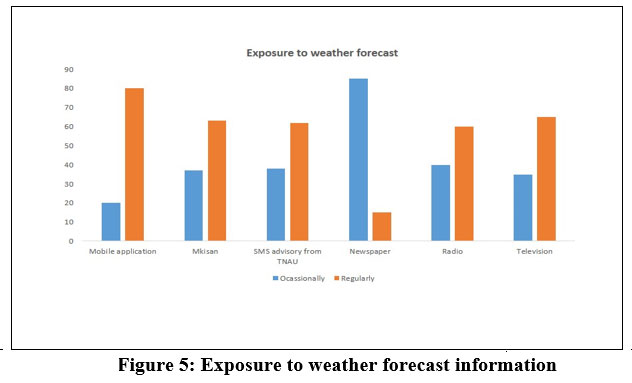 | Figure 5: Exposure to weather forecast information
|
Farmers response to TNAU-AAS App Handling skill
Through the telephonic survey and creation of Whats app group, registration of farmers in TNAU AAS app was done with smart phones. 92 per cent of the respondents could download the app from the play store, 83 % respondents could enter the details required by the app,
74 % respondents could enter the crop details in the app, 67 % respondents could access the message delivered in the app. 59 % respondents could follow up the messages in the app (Figure 6). Awareness should be created to realize that the farmers need to follow the advisories from the sowing to harvest to achieve better productivity and good income.
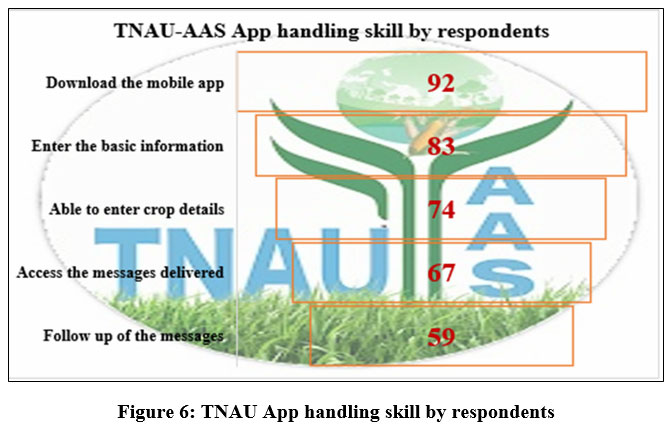 | Figure 6: TNAU App handling skill by respondents
|
Registered Farmer's perception towards Agromet Advisory Services
The perception about the Agro Advisory services (AAS) was rated as good by 45 per cent and average by 40 per cent of the respondents (Table 2). The quality of the information disseminated from the AAS was rated as good by 38 per cent and average by 51 per cent of the respondents. The willingness to pay for the AAS inferred that 65 per cent were not ready for the paid services while 15 per cent responded positively for the paid services and 20 per cent responded they were unable to give a clear picture towards payment structure. The advantage and requirement of AAS towards farmers’ need revealed that the AAS given during spraying operations against plant protection (94 %) followed by general farm operations (85%) and irrigation scheduling (83%). A parallel information on spraying operation importance on AAS in Tiruvallur district was reported17. The overall satisfaction of AAS was realized by 79 per cent of the respondents in the study area. This information collected from the respondents throws light to further improve the quality of the AAS by working out permutations and combinations of different weather combinations to the crops listed in the App.
Table 2: Registered Farmer's perception towards AAS in Western ACZ of Tamil Nadu
S. N | Farmers Perception statements | Frequency | % |
1 | Perception about AAS |
|
|
| Good | 108 | 45 |
| Average | 95 | 40 |
| Not Satisfactory | 37 | 15 |
2 | Quality of AAS disseminated |
|
|
| Good | 91 | 38 |
| Average | 122 | 51 |
| Not Satisfactory | 27 | 11 |
3 | Willingness for pay based services |
|
|
| Yes | 35 | 15 |
| No | 156 | 65 |
| Not decided | 49 | 20 |
4 | Advantage of AAS |
|
|
| General Farm operation | 205 | 85 |
| Irrigation scheduling | 200 | 83 |
| Intercultural operations | 125 | 52 |
| Spraying of chemicals | 225 | 94 |
| Post -harvest operations | 165 | 69 |
| Animal Husbandary | 170 | 71 |
5 | Overall satisfaction from AAS |
|
|
| Yes | 189 | 79 |
| No | 51 | 21 |
Conclusion
Information and communication technologies are becoming more prevalent in developing nations for the advancement of various people, including educators and farmers. The awareness level and adoption of TNAU-AAS Web cum Mobile App in the western ACZ of Tamil Nadu was explored in the current study. The app handling skill of the farmers were assessed in the present study to improvise the app for easy handling by the farmers. The feedback obtained based on the perception of this AAS provides an insight to improve the efficacy of the contents in the app to reduce the risk of the farmers due to various weather vagaries. To assure the quality, timeliness, and reliability of information, it is crucial to fully utilise the potential of information distribution made possible by mobile telephony coupled with supporting infrastructure and capacity building among farmers.
Acknowledgment
The author would like to thank Tamil Nadu Agricultural University for allowed to take up this web app services perception in Tamil Nadu.
Conflict of Interest
There is no conflict of interest in the manuscript.
Funding source
There is no funding or financial support for this research work
Reference
- Aker J. C, Ksoll C. Can mobile phones improve agricultural outcomes? Evidence from a randomized experiment in Niger. Food Policy 2016; 60, 44-51.
CrossRef - Balasubramanian T. N, Jagannathan R, Maragatham N, Sathyamoorthi K, Nagarajan R. Generation of weather windows to develop agro advisories for Tamil Nadu under automated weather forecast system. Journal of Agrometeorology 2014; 16(1) 60-68.
CrossRef - Baviskar D, Pareta K, Goswami D, Joshi M, Dhande H, Mukherjee A, ... Luchner J. India: Strengthening Climate Change Resilience in Urban India–Strengthening Smart Water Management and Urban Climate Change Resilience in Tamil Nadu (Subproject 1)–Part 14 of 27. 2019
- Bhavnani A, Chiu R. W. W, Janakiram S, Silarszky P, Bhatia D. The role of mobile phones in sustainable rural poverty reduction. retrieved November 2008; 22.
- Aker Jenny C, Isaac Mbiti. Mobile phones and economic development in Africa. Journal of Economic Perspectives 2010; 24(3)207-232.
CrossRef - Dharanipriya A, Karthikeyan C. Use of smart phones by farmers as a tool for information support in agriculture. J. Krishi Vigyan 2019; 7, 251-6.
CrossRef - Dharanipriya A, Karthikeyan C, Panneerselvam S. Understanding the farmers’ preference for designing weather based agro advisory services. Journal of Pharmacognosy and Phytochemistry 2019; 8(3)870-873.
- Dheebakaran G, Panneerselvam S, Geethalakshmi V, Kokilavani S. Weather based automated agro advisories: an option to improve sustainability in farming under climate and weather vagaries. In Global Climate Change and Environmental Policy Springer, Singapore 2020; 329-349.
CrossRef - IPCC. Assessment Report 6. 2022; https://www.ipcc.ch/report/sixth-assessmentreport- working-group-ii/
- Khan N. A, Qijie G, Ali S, Shahbaz B, Shah A A. Farmers’ use of mobile phone for accessing agricultural information in Pakistan: a case of Punjab province. Ciência Rural 2019; 49(10)1-12.
CrossRef - Kumar Y, Raghuvanshi M S, Fatima K, Nain M S, Manhas J S, Namgyal, ... Angchuk S. Impact assessment of weather based agro-advisory services of Indus plain farming community under cold arid Ladakh. MAUSAM 2021; 72(4)897-904.
CrossRef - Lehr D. Going Wireless: Dialling for Development (working paper). 2007; http://mobileactive.org/dialing-development. new-report-mobile-phone-use-base pyramid
- Munyua H. ICTs and small-scale agriculture in Africa: a scoping study. IRDC, Ottawa. 2007
- Prasad S A, Vijayashanthi V A, Manimekalai R, Yogameenakshi P, Pirathap P. Impact Assessment on Knowledge of Weather Based Agro-advisory Services among Farmers in Tiruvallur District, Tamil Nadu. Current Journal of Applied Science and Technology; 39(36)96-101.
CrossRef - Rama Rao C A, Raju B M K, Subba Rao A V M, Rao K V, Rao V U M, Kausalya Ramachandran, Venkateswarlu B, Sikka A K. Atlas on Vulnerability of Indian Agriculture to Climate Change. Hyderabad. Central Research Institute for Dryland Agriculture; 2013.116 p
- Sousa F, Nicolay G, Home R. Information technologies as a tool for agricultural extension and farmer-to-farmer exchange: Mobile-phone video use in Mali and Burkina Faso. International Journal of Education and Development Using Information and Communication Technology 2016; 12(3)19-36.
- FAO, IFAD, UNICEF, WFP and WHO. The State of Food Security and Nutrition in the World 2020. Transforming food systems for affordable healthy diets. Rome, FAO. FAO, IFAD, UNICEF, WFP and WHO 2020. 320 p






